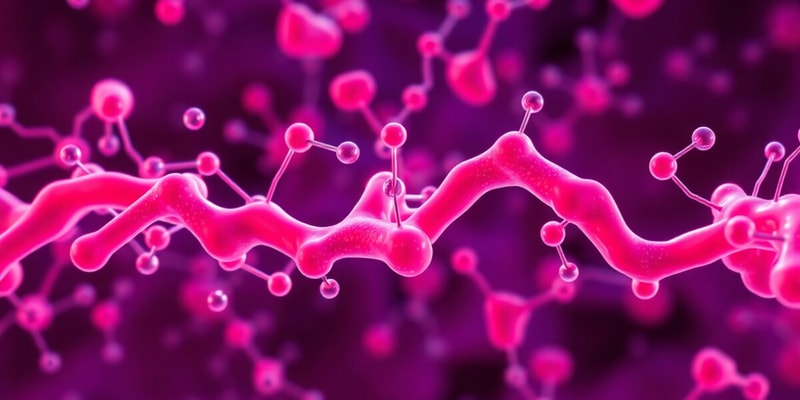Podcast Beta
Questions and Answers
What is the predominant stereoisomer of lactate produced in the body?
What happens to lactate mainly in the liver?
Which of the following statements about lactic acidosis is correct?
Which organs are primarily responsible for lactate metabolism?
Signup and view all the answers
What is the normal serum lactate concentration range?
Signup and view all the answers
Under which condition is lactate primarily produced?
Signup and view all the answers
What percentage of lactate is removed by the kidneys?
Signup and view all the answers
Lactic acidosis can be associated with various conditions. Which of the following is NOT commonly associated?
Signup and view all the answers
Study Notes
Lactic Acid Production
- L-lactate is the predominant stereoisomer among the two types of lactic acid, alongside D-lactate.
- Key substrates for intracellular L-lactate production include glucose and alanine via transamination mediated by alanine aminotransferase (ALT).
- In anaerobic conditions, pyruvate is reduced to lactate by lactate dehydrogenase (LDH) when the citric cycle is saturated.
Lactate Metabolism
- The liver is primarily responsible for converting lactate to glucose through gluconeogenesis in the Cori cycle, consuming 6 ATP molecules.
- The kidneys play a role in lactate removal, handling approximately 10 to 20% through excretion, gluconeogenesis, and oxidation.
- Other tissues can oxidize lactate to carbon dioxide and water, whereas only the liver and kidneys possess the necessary enzymes for lactate-to-glucose conversion.
Lactic Acidosis
- Lactic acidosis manifests when lactic acid production outpaces its clearance, characterized by:
- Serum lactate concentration exceeding 4 mmol/L (normal range: 0.5 – 1.5 mmol/L).
- Acidemia indicated by serum pH below 7.35.
Causes of Lactic Acidosis
- Inborn metabolic disorders linked to lactic acidosis include:
- Glucose-6-phosphatase deficiency (von Gierke disease, glycogen storage disease type I).
- Fructose-1,6-bisphosphatase deficiency.
- Pyruvate carboxylase deficiency.
- Pyruvate dehydrogenase deficiency.
- Oxidative phosphorylation deficiencies.
- Methylmalonic aciduria.
- MELAS syndrome is a neurodegenerative disorder caused by mutations in mitochondrial DNA, associated with lactic acidosis and strokes.
- Lactic acidosis can also arise from various conditions, including:
- Diabetes mellitus.
- Alcoholic ketoacidosis.
- Severe iron-deficiency anemia.
- Liver diseases and renal failure.
- Pancreatitis and short gut syndrome.
- Infections such as malaria and cholera.
- Certain malignancies, e.g., leukemia, lymphoma, lung cancer.
- Thiamine deficiency and carbohydrate malabsorption syndromes.
Studying That Suits You
Use AI to generate personalized quizzes and flashcards to suit your learning preferences.
Related Documents
Description
Explore the metabolic pathways of lactic acid production and its conversion in the body, focusing on L-lactate and D-lactate. Understand the role of the liver and kidneys in lactate clearance and the conditions leading to lactic acidosis. This quiz will deepen your knowledge of lactate metabolism and its physiological implications.




